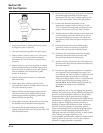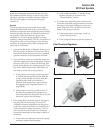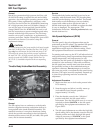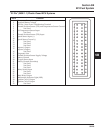
5B.22
Section 5B
EFI Fuel System
General
Special low permeation high-pressure fuel line with
an SAE 30 R9 rating is required for safe and reliable
operation, due to the higher operating pressure of the
EFI system. If hose replacement is necessary, order
Fuel Line Service Kit Part No. 25 111 37-S (containing
60” of high-pressure hose and 10 Oetiker clamps), or
use only the type of hose specified. Special Oetiker
clamps (Kohler Part No. 24 237 05-S) are used on all
fuel line connections to prevent tampering and safety
hazards with the high fuel pressure. The old clamp
must be cut to open a connection, so replacement is
necessary each time. Oetiker Clamp Pliers (part of EFI
Service Kit, see Section 2) is used to crimp the
replacement clamps.
CAUTION:
Fuel lines between the fuel pump and fuel rail must be made
from SAE 30 R9 fuel line. Standard fuel line (SAE 30 R7)
may only be used between the fuel tank and pump (5/16”
ID) and for the return line from the pressure regulator to
the tank (1/4” ID). All high-pressure fuel line connections
must be secured with Oetiker clamps (Kohler Part No.
24 237 05-S), installed/crimped with the corresponding
pliers.
Throttle Body/Intake Manifold Assembly
Service
The throttle body/intake manifold is serviced as an
assembly, with the throttle shaft, TPS, throttle plates,
and idle speed adjusting screw installed. The throttle
shaft rotates on needle bearings (non-serviceable),
capped with rubber seals to prevent air leaks. A
throttle shaft repair kit is available to replace the shaft
if worn or damaged. The appropriate “TPS
Initialization Procedure” must be performed after any
throttle shaft service.
Idle Speed Adjustment (RPM)
General
The idle speed is the only adjustment that may be
performed on the EFI system. The standard idle speed
setting for EFI engines is 1500 RPM, but certain
applications might require a different setting. Check
the equipment manufacturer’s recommendation.
For starting and warm up, the ECU will adjust the fuel
and ignition timing, based upon ambient temperature,
engine temperature, and loads present. In cold
conditions, the idle speed will probably be higher than
normal for a few moments. Under other conditions,
the idle speed may actually start lower than normal,
but gradually increase to the established setting as
operation continues. Do not attempt to circumvent
this warm up period, or readjust the idle speed during
this time. The engine must be completely warmed up,
in closed loop operating mode for accurate idle
adjustment.
Adjustment Procedure
1. Make sure there are no fault codes present in the
ECU memory.
2. Start the engine and allow it to fully warm up
and establish closed looped operation
(approximately 5-10 min.).
3. Place the throttle control in the ‘‘idle/slow’’
position and check the idle speed with a
tachometer. Turn the idle speed screw in or out as
required to obtain 1500 RPM, or the idle speed
specified by the equipment manufacturer. See
Figure 5B-33.
4. The idle speed adjustment can affect the high idle
speed setting. Move the throttle control to the full
throttle position and check the high idle speed.
Adjust as necessary to 3750 RPM, or the speed
specified by the equipment manufacturer.
Figure 5B-32. Upper Throttle Body/Intake Manifold
Details.
General
The EFI engines have no carburetor, so the throttle
function (regulate incoming combustion airflow) is
incorporated in the intake manifold assembly. The
manifold consists of a one-piece aluminum casting
which also provides mounting for the fuel injectors,
throttle position sensor, fuel rail, air baffle, idle speed
screw, and air cleaner assembly.


















